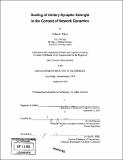| dc.contributor.advisor | Guosong Liu. | en_US |
| dc.contributor.author | Wilson, Nathan R. (Nathan Richard) | en_US |
| dc.contributor.other | Massachusetts Institute of Technology. Dept. of Brain and Cognitive Sciences. | en_US |
| dc.date.accessioned | 2006-07-31T15:22:30Z | |
| dc.date.available | 2006-07-31T15:22:30Z | |
| dc.date.copyright | 2005 | en_US |
| dc.date.issued | 2005 | en_US |
| dc.identifier.uri | http://hdl.handle.net/1721.1/33675 | |
| dc.description | Thesis (Ph. D.)--Massachusetts Institute of Technology, Dept. of Brain and Cognitive Sciences, 2005. | en_US |
| dc.description | Includes bibliographical references (leaves 93-97). | en_US |
| dc.description.abstract | A fundamental consideration in understanding neuronal networks is determining what sets the unitary functional strength of a synaptic connection between two cells, and what meta-processes such mechanisms answer to. This question can be asked either mechanistically, by characterizing the molecular processes that regulate the synapse's transmission, or ontologically, by considering the impact of this transmission from the standpoint of neighboring synapses, the post synaptic cell itself, or the network of neurons in which it is situated. The work presented here practices both approaches, by identifying a new molecular mechanism to which the quantal size of excitatory synapses can be attributed, and then beginning to explore how quantal size might be influenced by network activity and architecture. Chapter 1 identifies a new molecular control point for specifying the quantal size of excitatory transmission in the mammalian brain, and provides the first known demonstration that such specification can be provided by a presynaptic process. It then details how this mechanism is regulated by network activity. | en_US |
| dc.description.abstract | (cont.) Chapter 2 makes use of a new methodology for designing the physical structure of cultured networks in order to begin to perturb network parameters and explore the role of quantal size in a network context. Applying this methodology I demonstrate that the quantal size of excitatory synapses is scaled by neurons inversely with their number of synaptic connections, and identify a set of mechanisms by which network firing is maintained at a constant level when the number of active synaptic partners is scaled. Chapter 3 demonstrates progress towards a methodology capable of producing and detecting changes in the unitary strength of multiple synapses with respect to one another within a dendritic tree. Future efforts can hopefully make use of similar principles to directly visualize how heterosynaptic processes establish and maintain a contrast in the strengths of unitary synapses to enable representation by synaptically-based memory traces. | en_US |
| dc.description.statementofresponsibility | by Nathan R. Wilson. | en_US |
| dc.format.extent | 97 leaves | en_US |
| dc.format.extent | 5492490 bytes | |
| dc.format.extent | 5496535 bytes | |
| dc.format.mimetype | application/pdf | |
| dc.format.mimetype | application/pdf | |
| dc.language.iso | eng | en_US |
| dc.publisher | Massachusetts Institute of Technology | en_US |
| dc.rights | M.I.T. theses are protected by copyright. They may be viewed from this source for any purpose, but reproduction or distribution in any format is prohibited without written permission. See provided URL for inquiries about permission. | en_US |
| dc.rights.uri | http://dspace.mit.edu/handle/1721.1/7582 | |
| dc.subject | Brain and Cognitive Sciences. | en_US |
| dc.title | Scaling of unitary synaptic strength in the context of network dynamics | en_US |
| dc.type | Thesis | en_US |
| dc.description.degree | Ph.D. | en_US |
| dc.contributor.department | Massachusetts Institute of Technology. Department of Brain and Cognitive Sciences | |
| dc.identifier.oclc | 64583644 | en_US |
